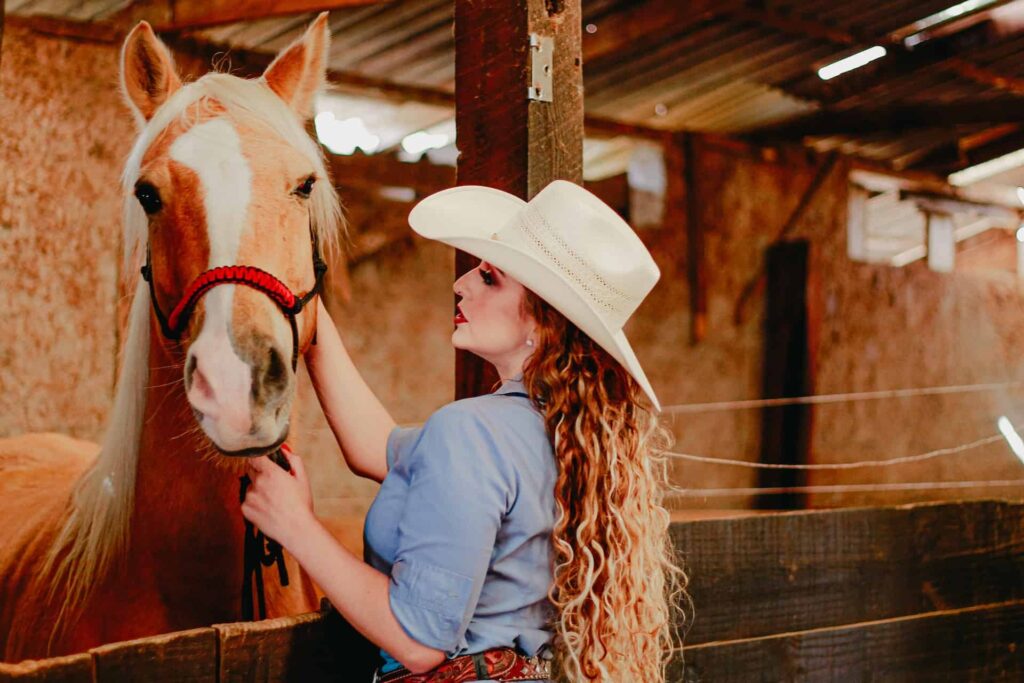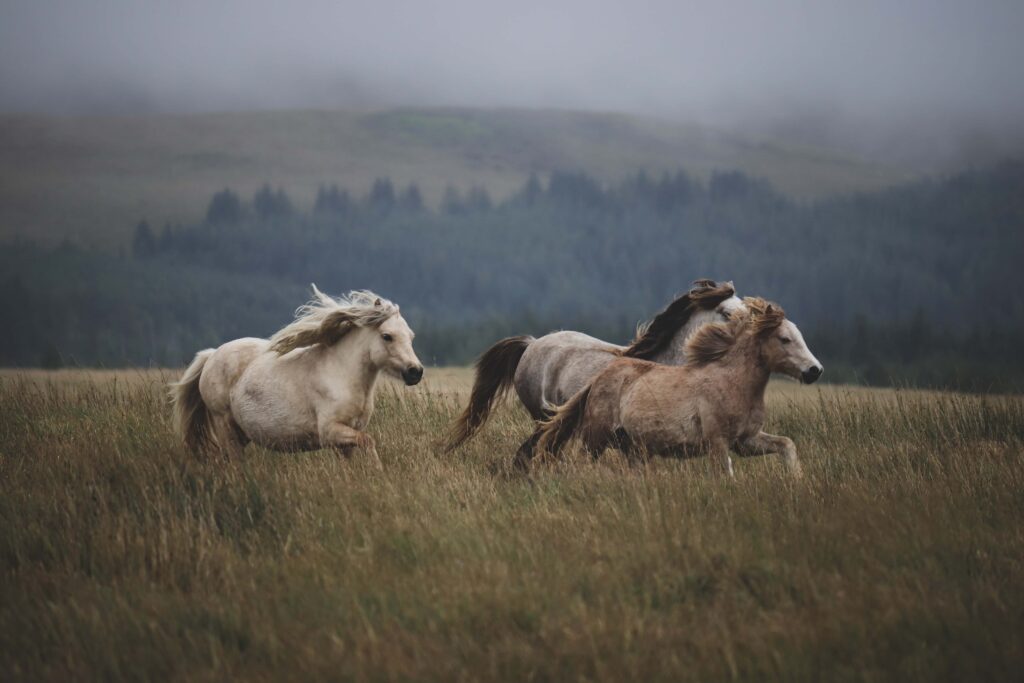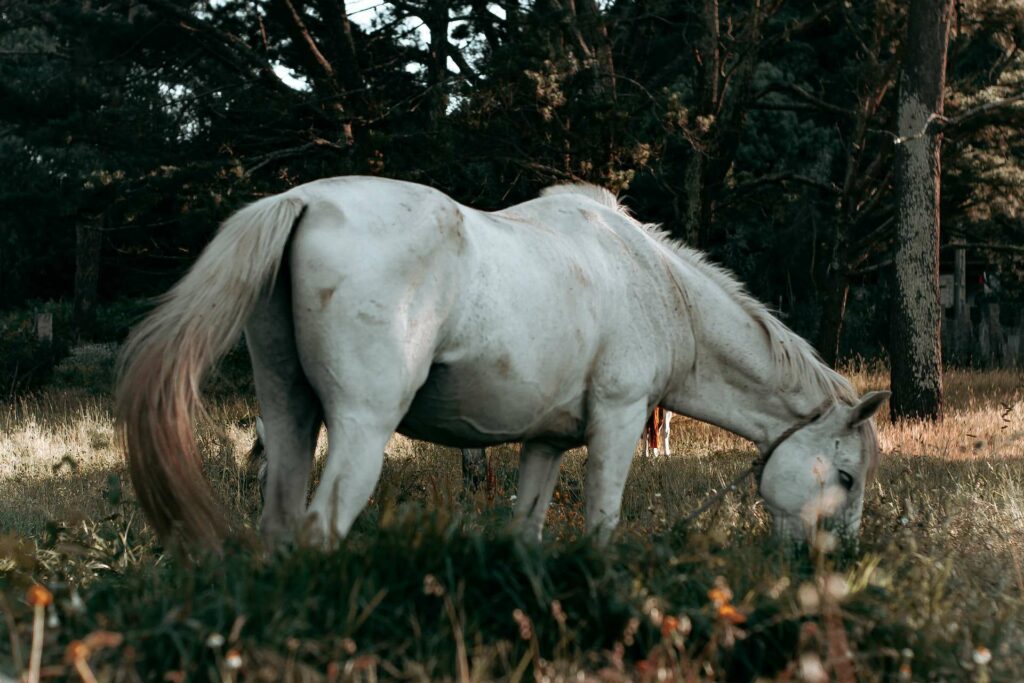Horse bedding is an essential component in the management of stabled horses, influencing not only comfort but also hygiene and health. Different types of bedding materials are available to horse owners, each with a unique set of properties that cater to varying needs and preferences. These range from traditional straw to more innovative options like shredded paper or wood pellets, and they play a crucial role in the daily lives of horses.
Selecting the right bedding is a balance between ensuring the well-being of the horse and addressing practical considerations such as cost, availability, and ease of management. The ideal bedding should provide a soft and absorbent layer that cushions joints, insulates against cold, and rapidly wicks away moisture to maintain a dry environment. Alongside comfort, bedding for horses must also meet standards of hygiene to minimize the risk of respiratory issues or other ailments caused by dust and ammonia.
Bedding choices are also informed by environmental factors; biodegradability and compostability affect manure management and disposal. Horse owners must navigate these decisions while keeping economic and practical considerations in mind, ensuring the chosen bedding aligns with their resources and stable management routines.
Key Takeaways
- Horse bedding is crucial for equine comfort and hygiene.
- The right bedding balances health needs with practicality.
- Environmental factors influence bedding material choice.
Types of Horse Bedding
Choosing the right bedding for horses is crucial for their health and comfort. This section outlines various types of bedding materials, focusing on their respective benefits and considerations when it comes to absorbency, maintenance, and compostability.
Straw Bedding
Straw bedding is traditional and widely used due to its availability and biodegradability. It has moderate absorbency and provides a comfortable surface for horses. However, the composting of straw can be slower compared to some other materials, and it might not be the most absorbent bedding option available. Research suggests that the type of straw and its preparation can affect its suitability as equine bedding.
Wood Shavings and Sawdust
Wood shavings and sawdust are popular bedding materials known for their high absorbency and ease of use. However, dust levels can be a concern with these options, as excessive dust can contribute to respiratory problems in horses. The selection of low-dust wood shavings is essential for equine respiratory health. These bedding types are also relatively easy to compost.
Pelleted Bedding
Pelleted bedding made from wood pellets is highly absorbent, easy to store, and easy to handle. They expand when wet, making them efficient at moisture absorption. Wood pellets break down into sawdust, which can then be composted. While the initial cost may be higher, the ease of mucking out and lower volume of waste produced can be cost-effective in the long run.
Alternative Bedding Materials
There are a variety of alternative bedding options including peat moss, paper bed, cardboard, rubber mats, sand, and rice hulls. Each material has its unique properties; for instance, peat moss is highly absorbent and biodegradable, while rubber mats reduce the amount of bedding needed but require a top layer of a more absorbent material. Paper and cardboard provide low-dust environments but vary in absorbency and compostability. Sand has to be managed carefully to prevent ingestion and associated health problems, and rice hulls are less common but offer another biodegradable option for horse owners.
Bedding Characteristics
Choosing the right bedding for equine facilities is critical to ensure the health and comfort of horses. The characteristics such as absorbency, cushioning, and dust levels must be closely considered to maintain a clean and safe environment.
Absorbency Factors
Bedding materials greatly vary in their absorbency rates, which is crucial for maintaining a dry and odor-free stall. Sawdust and straw are common choices because of their ability to hold significant moisture. Studies have examined composting characteristics of bedding materials like sawdust, highlighting their moisture-absorbing capabilities. Materials that are highly absorbent help in managing ammonia levels, reducing odors, and promoting a cleaner stall.
Comfort and Cushioning
The comfort provided by bedding is essential for a horse’s rest and joint health. A cushioned surface is fundamental to prevent sores and injuries. Wood shavings, for example, offer a soft layer that can buffer the hard surface of the barn floor. Adequate cushioning supports the horses when they lie down, ensuring they are rested and free from stress-induced behaviors.
Dust and Respiratory Health
The level of dust in bedding is a critical concern, as it can lead to respiratory problems in horses. Low dust or dust-free options, such as specially processed wood pellets, help to minimize the risk of respiratory issues. The effects of different bedding materials on the behavior of horses extend to their impact on the quality of breathable air, with dusty environments being detrimental to equine respiratory health.
Management of Allergies and Toxins
Certain bedding materials can exacerbate allergies or introduce toxic substances to horses. Black walnut, for instance, is known to be toxic to horses and should never be used in bedding. Cleanliness is also crucial in allergy management; regular removal of soiled bedding reduces exposure to potential allergens. Bedding materials low in dust and without toxic properties are preferred to minimize allergic reactions and maintain overall health.
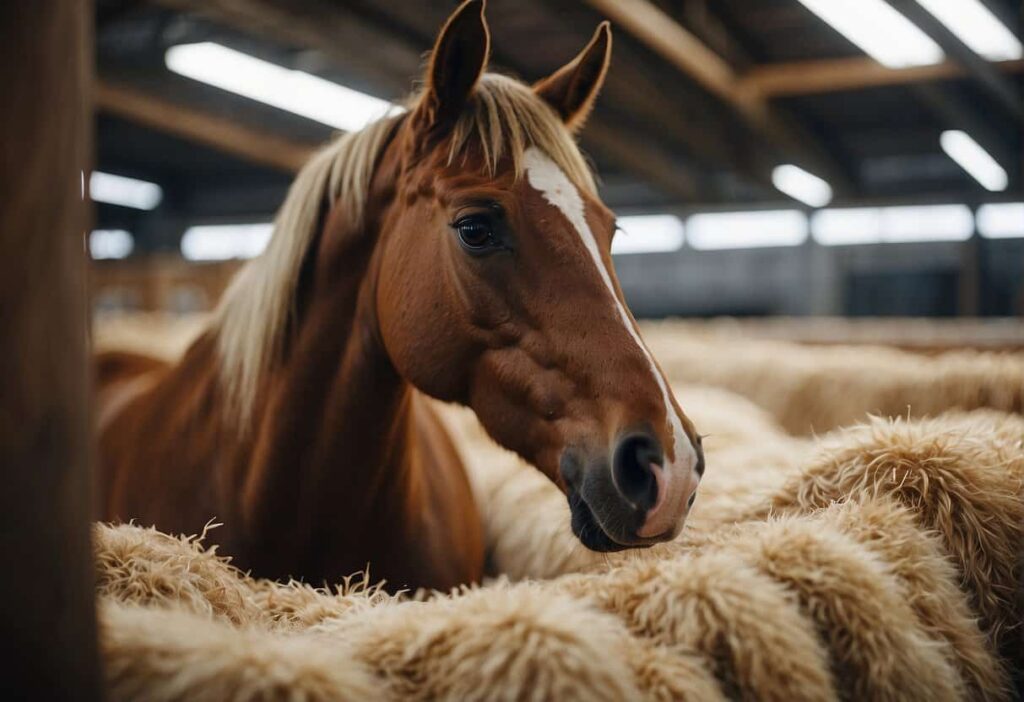
Health and Safety Concerns
In the management of horse stables, understanding the health and safety concerns associated with bedding is critical. Factors such as bacterial and mold risks, impact on hoof and respiratory health, and toxin exposure and ingestion must be taken into account to ensure the well-being of these animals.
Bacterial and Mold Risks
Clean bedding is essential to prevent the proliferation of bacteria and mold, which thrive in damp and dirty environments. Mold can lead to respiratory issues, while bacterial growth may result in infections. It is crucial to regularly remove soiled bedding to minimize these risks. Bedding materials should be stored in a dry environment to discourage mold formation which can notably affect a horse’s health if unmanaged.
Impact on Hoof and Respiratory Health
Exposure to damp or dirty bedding can increase the incidence of thrush, a bacterial condition affecting the hoof. Adequate drainage and clean, dry bedding are necessary to maintain optimal hoof health. On the other hand, dusty bedding materials can contribute to respiratory issues, including inflammatory airway disease. Selection of low-dust bedding options is advised to safeguard the respiratory health of stabled horses.
Toxin Exposure and Ingestion Risks
Bedding that contains toxic substances, such as glue from recycled materials, poses a risk if ingested, potentially leading to impaction colic. It’s vital to use safe bedding materials that reduce the likelihood of ingestion and impaction. The absorption quality of the bedding also directly affects ammonia levels—materials that do not adequately absorb urine can increase ammonia exposure, which can be harmful to both respiratory and overall health.
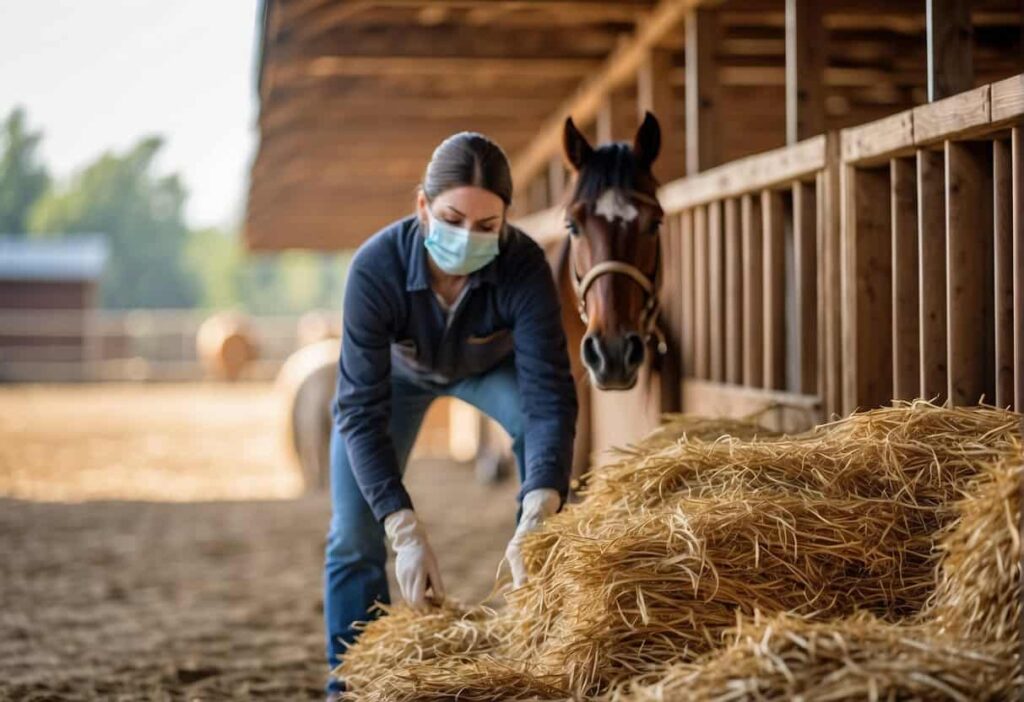
Economic and Practical Considerations
When selecting horse bedding, economic and practical aspects play a critical role. Owners must weigh the balance between cost-effectiveness and the ease of stall cleaning and maintenance, while also considering factors such as storage requirements and bedding availability.
Affordability and Budgeting
Horse bedding should fit into the stable owner’s budget, taking into account not only the initial cost but also the long-term expenses associated with its use. Different materials can vary widely in price; some types may be more cost-effective due to their greater absorbency or longer lifespans. For instance, pine shavings may initially seem expensive, yet their superior moisture management can reduce the frequency of replacement.
- Initial Bedding Cost: Price per cubic foot or bag
- Longevity: How often bedding needs to be replaced
- Absorbency: Amount of moisture bedding can contain before changing
Ease of Cleaning and Maintenance
The choice of bedding greatly impacts the labor involved in cleaning stalls. Materials that clump or sift easily allow for more efficient stall cleaning, saving time and labor costs. Bedding that contributes positively to the ventilation within the stable is desirable, as it maintains a healthy environment for the horse and reduces odors.
- Manure Removal: Bedding ease of separation from waste
- Dust Levels: Impact on stable air quality
- Ammonia Control: Bedding’s ability to neutralize urine odors
Storage and Handling
Storage plays a crucial role in bedding selection. Some bedding types are easy to store and handle, making them suitable for stables with limited space. The climate and weather conditions can influence the suitability of storage methods, and ease of transport influences how quickly and efficiently bedding can reach the stalls.
- Bulkiness: Space required for storage
- Packaging: Whether bedding is sold in compact forms
- Durability: Bedding’s resistance to weather when stored
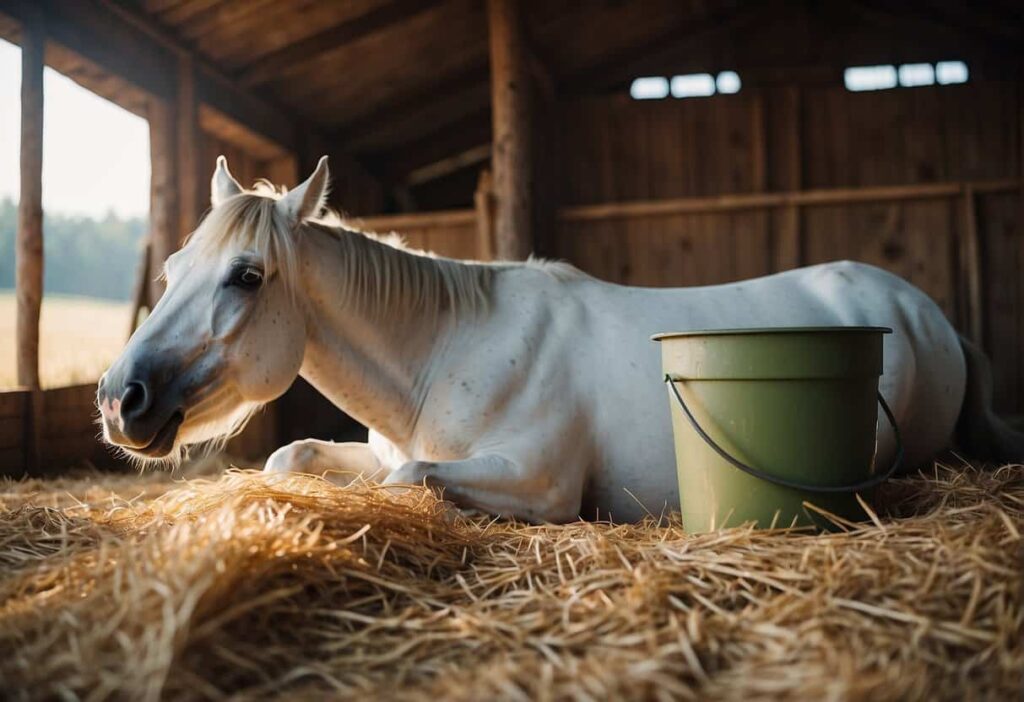
Environmental Factors
When selecting bedding materials for horses, environmental factors are essential considerations that impact sustainability and the climate resilience of stabling practices.
Sustainability and Biodegradability
Sustainable horse bedding options are not only essential for reducing waste but also for facilitating eco-friendly disposal methods. Biodegradable materials, such as wood shavings, straw, and pelleted newspaper, offer alternatives that are readily available and can effectively be composted. Composting bedding creates a compost pile that contributes to a circular economy, transforming waste into valuable fertilizer for plants.
- Wood shavings: Highly biodegradable and compostable; available from timber industry by-products.
- Straw: Traditional material; biodegradable and often sourced as a by-product of grain production.
- Pelleted newspaper: Made from recycled paper; biodegradable and can absorb moisture well, which is beneficial for composting.
The availability of these materials can vary regionally, affecting their status as eco-friendly choices. Therefore, it’s important to consider local resources when evaluating bedding options to ensure they are readily available and do not require excessive transportation, which itself could have environmental impacts.
Climate Considerations
Climate plays a significant role in the selection of horse bedding, influencing the insulation properties required and the weather-related durability of the materials. For example, in colder climates, bedding with good insulation properties is crucial for maintaining warmth within the stable.
- Straw: Offers excellent insulation against cold weather but can be prone to dampness in wet climates.
- Wood shavings: Generally provide good insulation and are less likely to mold in humid conditions compared to straw.
Moreover, the ability to compost bedding is affected by climate. In wetter climates, composting is slower, and the biodegradable bedding may need to be managed more actively to ensure proper decomposition. Conversely, in drier climates, maintaining a compost pile can require additional water to aid in the composting process. It’s imperative to account for these variables to maintain an eco-friendly stable environment.
Frequently Asked Questions
When selecting the best bedding for horses, it is important to consider factors like absorbency, comfort, dust levels, cost, and ease of mucking out.
What factors should be considered when choosing the best horse bedding material?
Choosing the right horse bedding material requires considering absorbency, which impacts both comfort and stable hygiene. The bedding should also have minimal dust to ensure respiratory health for both horses and handlers.
How does the use of rubber mats impact the selection of horse bedding?
Rubber mats can provide cushioning and reduce the amount of bedding needed. When used, they create a semi-permanent, easy-to-clean layer, allowing for potentially less absorbent but more cost-effective bedding materials on top.
Which horse bedding options are known for being the most cost-effective?
Straw and wood shavings are often the most cost-effective horse bedding options. They are readily available and provide reasonable levels of comfort and absorbency.
What are the dust-free bedding alternatives for horses to ensure a healthy stable environment?
Paper-based products and specially processed wood products offer dust-free alternatives. For instance, recycled phone book paper has been evaluated as a viable bedding option that is dust-free.
Can pine shavings be safely used for horse bedding, and what are the pros and cons?
Pine shavings are commonly used for horse bedding as they are absorbent and have a pleasant scent. However, they can be dusty unless specifically processed for dust reduction and may not be suitable for horses with respiratory issues.
Are there any suitable horse bedding materials that can also be used safely as cat litter?
Paper-based bedding materials, which are absorbent and low in dust, can double as cat litter. They are biodegradable and typically safe for equine and feline use, offering a multi-purpose solution for pet owners.
Last Updated on January 4, 2024 by Nate Dewsbury
